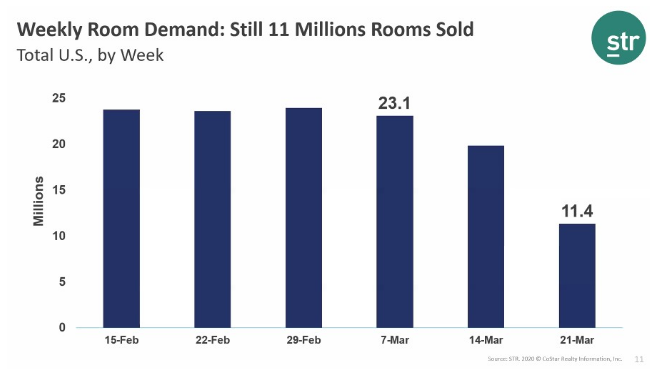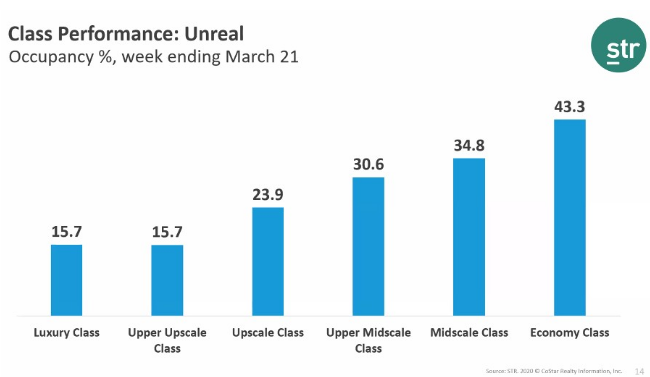Hotels across the USA and many other countries have closed or have plans to close down. Recent hotel industry data indicate hotel closures across the USA may not be happening quickly enough. Hotel News Now – Inside weekly US data: Looking at comparisons, classes published a graph comparing the impact of Covid-19 on hotel occupancy for China, Italy and U.S. over past two months. U.S hotel industry data for the past three weeks shows a serious drop in occupancy rates for many of the country’s largest hotel markets. However, graphic evidence from hotel industry data company STR shows there has not been as steep a downward curve in the U.S. hotel occupancy rate as seen in China and Italy in the month after they started combating Covid-19 spread.
Are hotels across the USA closing quickly enough to slow the spread of Covid-19?

The week ending March 7 was the beginning of Covid-19 panic in the USA. The peak of the graph shows dates for the week prior to major government action in China (Jan 18), Italy (Feb 22) and USA (Mar 7) including travel restrictions to slow Covid-19 spread in a country. This also coincides with general public knowledge in these nations of serious health warnings against travel.
China
Hotel occupancy
- Jan 18 = 65%
- Jan 25 = 30%
- Feb 8 = 20%
- Feb 15 = 8%
- Mar 14 = 18%
China experienced a steep drop in hotel occupancy from Jan 18 to Jan 25. Even more astounding than a hotel occupancy drop from 65 to 30% across China in one week is the fact that this drop happened during the week of Chinese New Year on Saturday January 25. Chunyun or Chinese New Year is one of the busiest travel periods of the year over six weeks of winter. Covid-19 was initially detected in Wuhan, China in December 2019 as several people came to hospitals with pneumonia and severe respiratory issues. During the first three weeks of January, Covid-19 spread extensively throughout Wuhan. By January 20 the disease appeared in Beijing and by January 22 several areas of China locked down in an effort to contain Covid-19.
Too late.
Covid-19 had already spread by the end of January to several other countries like South Korea, Italy, and states of California and Washington.
Italy
Hotel occupancy
- Feb 22 = 65%
- Feb 29 = 30%
- Mar 7 = 20%
- Mar 14 = 6%
Milan and major cities in Italy
- Feb 19 =Â 93% in Milan during Fashion Week. Milan and Lombardy quickly became the Covid-19 outbreak epicenter in Italy during March.
- March 1 = 8.5% in Milan.
- March 1 = 6.0% Venice.
- March 1 = 14% Florence.
- March 1 = 21% in Rome.
The first case of Covid-19 in Italy was detected January 31. News of a cluster of 16 persons with confirmed Covid-19 came Thursday, February 20 followed by another cluster of 60 persons on February 22 in northern Italy. Italy closed down several towns on February 22. China had already recorded more than 75,000 cases by that date.
Covid-19 was still not much of a UK or USA travel issue on February 22 when I flew from London LHR to SFO. There were no signs I recall about Covid-19 at Heathrow Airport. Seeing about 30% of passengers wearing masks in the passport control line at SFO had me wondering at the time why more airport officials were not wearing masks.
Similar to China, hotel occupancy in Italy dropped from 65% to below 30% in one week from February 22-29. Both China and Italy saw hotel occupancy drop to teens within two weeks and single digits within three weeks of widespread public awareness of Covid-19 within their borders.
Italy surpassed 40,000 Covid-19 cases as of March 19 with 3,455 deaths, more than 3,133 deaths recorded in Wuhan and Hubei Province, China where the pandemic disease originated about four months ago. By March 30, Italy recorded 97,689 Covid-19 cases and 10,779 deaths. During the 11 day period from March 19 to March 30 as Italy saw more than 6,000 additional deaths attributed to Covid-19, Hubei Province, China recorded only 53 additional deaths in the original hot spot for Covid-19.
France
Hotel occupancy
- Feb 26 = 65.3%
- During the two weeks from March 3-17 hotel occupancy across France dropped from about 37% to 3%. France closed its borders March 17 with a ban on all social gatherings.
USA
Hotel occupancy
- Mar 7 = 61.8%
- Mar 14 = 53.0%
- Mar 21 = 30.3%
- Mar 28 = 22.6%
Hotel occupancy in the USA was maintaining weekly occupancy around 60% on March 7. Later in the week President Trump restricted travel for 30-days to the USA for most foreigners who had been in Schengen zone countries during prior 14 days. Americans who had been in Schengen Zone would need to self-isolate in the U.S. for 14 days. UK and Ireland travelers who had not been in Schengen Zone in previous 14 days were exempt from these restrictions. although these countries were added a few days later.
While data from several cities impacted by Covid-19 saw occupancy decline to single digits, the overall 22.6% occupancy for all USA hotels for the week ending March 28 indicates far more travel still happening across the country at a time when large parts of the country have effectively highly restricted movement.
March 7 hotel occupancy data from STR
- Anaheim/Santa Ana, California, experienced the largest drop in occupancy (-27.3% to 59.6%).
- Seattle, Washington, saw the second-steepest decrease in occupancy (-26.4% to 52.3%).
- New York, New York, occupancy fell 13.1% to 72.1%.
- Detroit, Michigan saw a rise in occupancy (+1.9% to 62.2%).
- Nashville, Tennessee (+1.8% to 75.8%).
- 23.1 million occupied room nights for week ending March 7.
March 14 hotel occupancy data from STR
- Seattle, Washington, 32.9% saw steepest decrease in occupancy.
- San Francisco 38.9%
- New York, New York, 48.8%.
March 21 hotel occupancy data from STR
- San Francisco 16.6%.
- New York, New York, 16.8%.
- New Orleans 20.2%.
- 11.4 million occupied room nights for week ending March 21.
March 28 hotel occupancy data from STR
- Oahu, Hawaii 10.5% saw steepest decrease in occupancy.
- New Orleans 12.7%.
- New York, New York, 15.2%.
- Seattle 18.5%.
A closer look at the STR data for March 21 shows a steeper decline at higher hotel market segments with luxury and upper upscale hotels showing the greatest occupancy decline to 15.7% for the week ending March 21 compared to lower market segments of economy class hotels at 43.3% and midscale hotels at 34.8% occupancy. The higher occupancy is partly attributed to long term stays for many guests at economy class hotels.
In 2008, as the Great Recession took hold, the hotel occupancy impact hit luxury and upper upscale hotels more rapidly than lower market segment hotels. That turned into a great opportunity for hotel travelers to get deep discounts. I used my stimulus check of 2009 to travel around California and earn Hyatt Gold Passport Diamond elite status on relatively low hotel rates for San Francisco and other places. I spent more nights at luxury hotels in 2009 than I had before or since.
2020 is an even more severe crisis with numerous hotel closures due to travel restrictions from Covid-19. In my area of Monterey, two of the Hyatt affiliated properties of Carmel Valley Ranch and Ventana Big Sur Inn have closed down for the foreseeable future of Covid-19 travel restrictions.
Some hotels have focused on housing health care workers and other essential personnel working through the Covid-19 epidemic. Other hotels have been converted to shelters for homeless and sick. Asilomar Hotel and Conference Center in Pacific Grove was used to house mildly sick Covid-19 passengers from the Grand Princess cruise ship that docked March 9 at Port of Oakland.
In Monterey County and the San Francisco Bay area we have been in a shelter in place situation since the week of March 16. The fact that many states have only adopted these measures in the past week means the Covid-19 epidemic will continue a bit longer for the nation than could have been if the nation had adopted a uniform policy of closing down.
Something I recall reading in the days between Italy partially shutting down with restaurants remaining open during daytime was the response of a Chinese health care expert who commented Italy was not taking the coronavirus issue seriously enough to implement a full shut down.
Hotel occupancy across the USA at 22% for the week ending March 28 indicates we may have not shut down sufficiently to shorten the impact of Covid-19 on our health and economy.
Will we see single digit hotel occupancy across the USA next week?







3 Comments
Comments are closed.